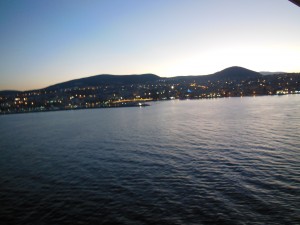
After a restful day at sea, we arrived at Kusadasi, Turkey just as the sun was rising. Lights flickered along the tranquil shoreline. We were eager to explore Ephesus. We had picked an early Celebrity tour so that we could avoid the crowds and also have time to explore the coastline afterwards.
Brief History of Ephesus
Ancient Ephesus dates back to 6000 BCE. The ruins at Ephesus are not as old. This ancient city was founded by Lysimakhos, one of Alexander the Great’s generals in 287 BCE. It was the capital and largest port city of the Roman Province of Asia during the Roman and Hellenistic periods.
Ephesus
The ancient city Ephesus is located in Selcuk, a small town 30km away from Kusadasi. Our group was the first to enter this historic site. We had the luxury of taking pictures with few people in the background. Our guide led us on the stone pathway. Archaeological excavations and partially restored buildings could be viewed from both sides of the path. In some areas, the viewing was restricted. Ropes marked off certain areas. Signs provided basic facts.
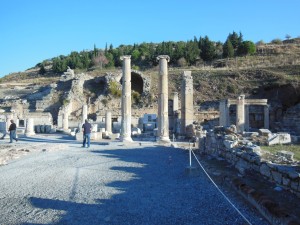
Baths at the State of Agora
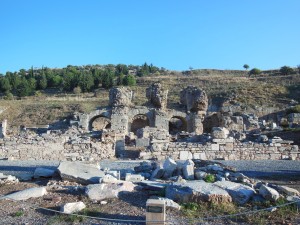
From a distance, the columns were visible. We were unable to see the bathing rooms created from the rock, the hot room, the bathing pools or the mosaic floor.
Basilica Stoa (Royal Colonnade)
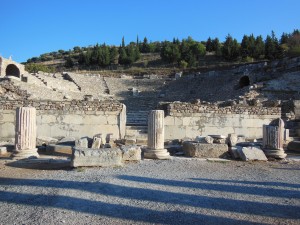
This structure was built in 11 CE. It had 67 columns and three aisles. The statues of Augustus and Livia were moved to the Ephesos Museum.
Bits and Pieces of the Ruins
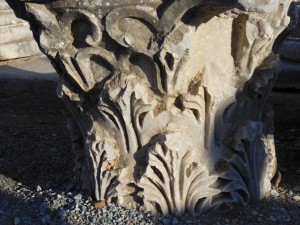
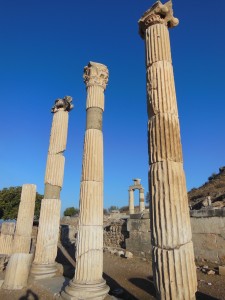
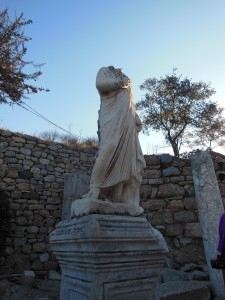
The Prytaneum
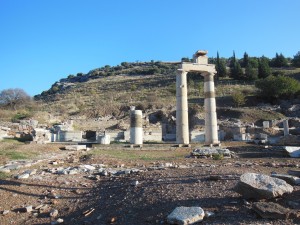
This building dates back to the Augustan Period (27 BCE-14 CE) It was the office of the city’s leading dignitary. The reconstructed columns are a notable trademark.
The Processional Way
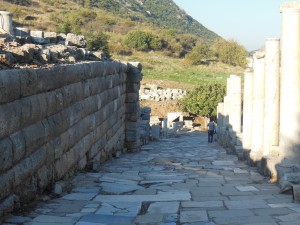
Memmius Monument
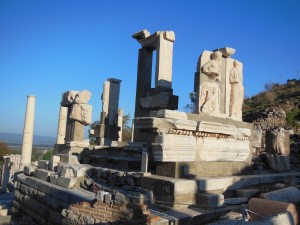
Built between 50-30 BCE, this monument was built to honor Gaius Memmius the grandson of Roman dictator Sula.
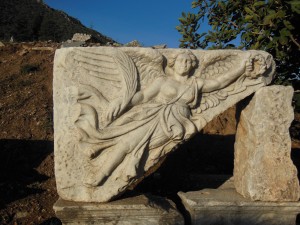
Stone Walkway
During part of the tour,we traversed on an inclined road paved with oversized pieces of irregular sized stone.
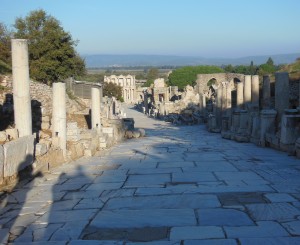
Nymphaeum Traiani
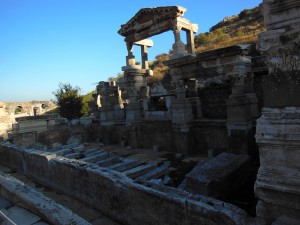
This fountain building was donated by Tiberius Caludius Aristion and his wife between 102 and 114 CE.
The So-called Alytarchs’ Stoa
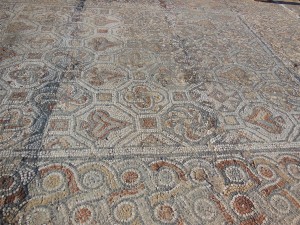
This hall is located on Curetes Street and borders between the two terrace houses. We were drawn to the multicolored mosaic floor that included geometric designs, florals and assorted figures. (4th-5th century CE)
The Temple of Hadrian
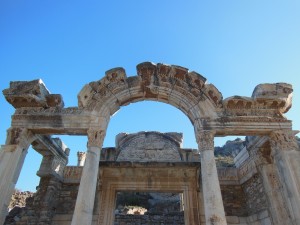
It was built to honor Emperor Hadrian (117-138 CE). The reliefs over the door lintel illustrate the Ephesian Foundation myth. Most will remember Hadrian for his contributions to Rome and Athens. As a Jew, I remember the diabolic role Hadrian played in Jewish history. At first he showed compassion to the Jews by allowing them to return to Jerusalem and granted them permission to rebuild their Temple. The Jews started to make arrangements and then Hadrian changed his mind. Hadrian deported Jews to North Africa, outlawed ritual circumcision, and started to build a temple to Jupiter on the site of the former Jewish Temple.
Under Shimon Bar-Kohkba leadership, the Jews revolted. Hadrian’s military might suppressed the uprising. Jerusalem was leveled and the Jews were forbidden to visit except during the 9th of Av to mourn their losses. Hadrian changed the country’s name from Judea to Syria Palestina. Hadrian’s distaste for the Jews translated into harsh anti-Jewish decrees that prohibited Jewish observances. Jews were forced to assimilate or become martyrs.
Stray Cat
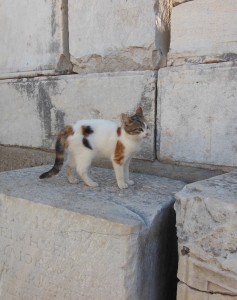
Cats were everywhere. Each reminded us of our cat, Chloe.
Jewish Presence in Ephesus
Historical references indicate that there was once a Jewish community in Ephesus. The exact dates of the community’s existence are not known nor have the remains of a synagogue been excavated. Paul preached early Christian teachings in an Ephesus synagogue. Jews were granted citizenship during the Hellenistic period while during the Roman period, Jews were exempt from military service in deference to Jewish law. Other documents indicate that Jews were allowed to practice their Judaism openly even though inscriptions on Jewish tombs indicate assimilation.
Celsus Library Menorah
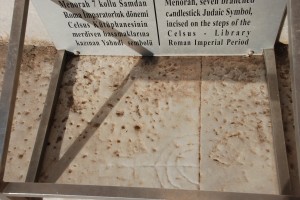
A 7 branched candelabra engraved into the library steps (Roman Imperial Era) demonstrates evidence of a Jewish presence in Ephesus.
Celsus Library
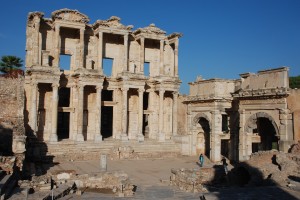
The library, a notable Ephesus landmark, was built in the beginning of the 2nd century CE by Gaius Iulius Aquila. It was destroyed by a devastating earthquake in 270 CE. It was rebuilt in the 1970s.
The Great Theatre
The first phase started between the 3rd-1st century BCE. Additions were made during the 1st and 2nd centuries CE. It was an ideal location for theatre performances and assemblies. During the Imperial period it was used for gladiatorial contests.

The Arachane
This impressive boulevard connecta the harbor to the Great Theatre.The road was 500 meters long and 11 meters wide.
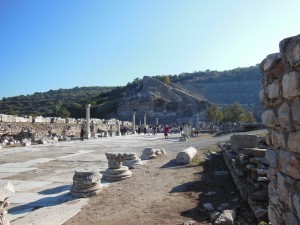
Necropolis
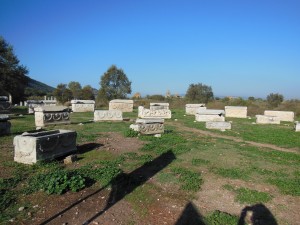
The Necropolis or “City of Death” was traditionally found outside the city walls. The Ephesus necropolis was a short distance from the gate and contained walled family tombs, monumental tombs, vauted tombs and sarcophagi within closed or open chambers. The sarcophagi were rectangular and were constructed of marble, stone, baked clay, or wood. Ephesus was one of the production sites for sarcophagi during ancient times.
Kusadasi Shoreline
Cruise tours usually include a sales stop. This time our tour included a carpet store within walking distance to the ship. We quickly left behind the heavy-handed sales pitch and opted to walk along the shoreline. We strolled and enjoyed the glorious day before we returned to the ship.
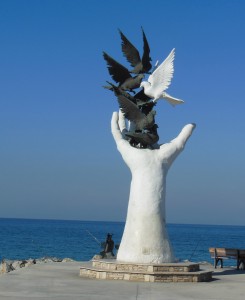
Sandra Bornstein is the author of MAY THIS BE THE BEST YEAR OF YOUR LIFE. It is available on Amazon.
If you enjoyed reading my memoir, consider posting a review on Amazon, Goodreads, LibraryThing and/or AskDavid.com.
Leave a Reply
You must be logged in to post a comment.